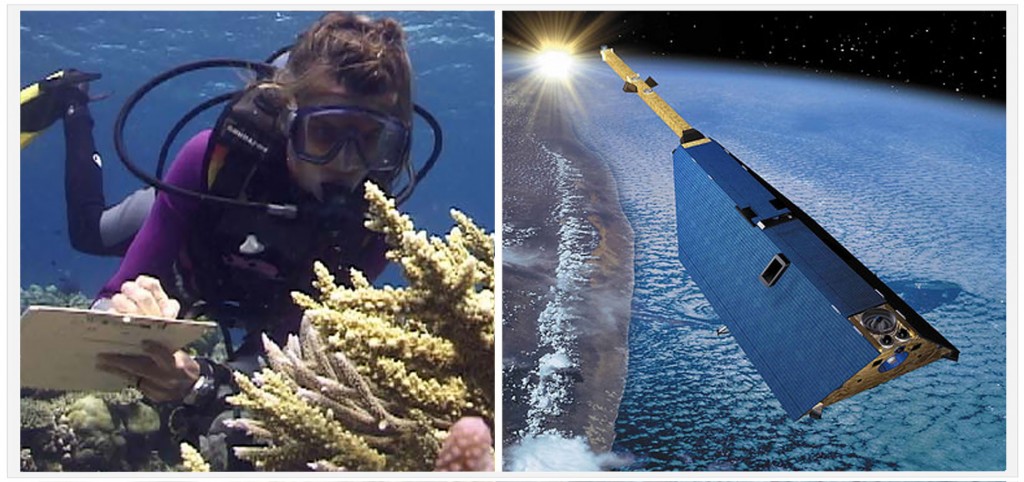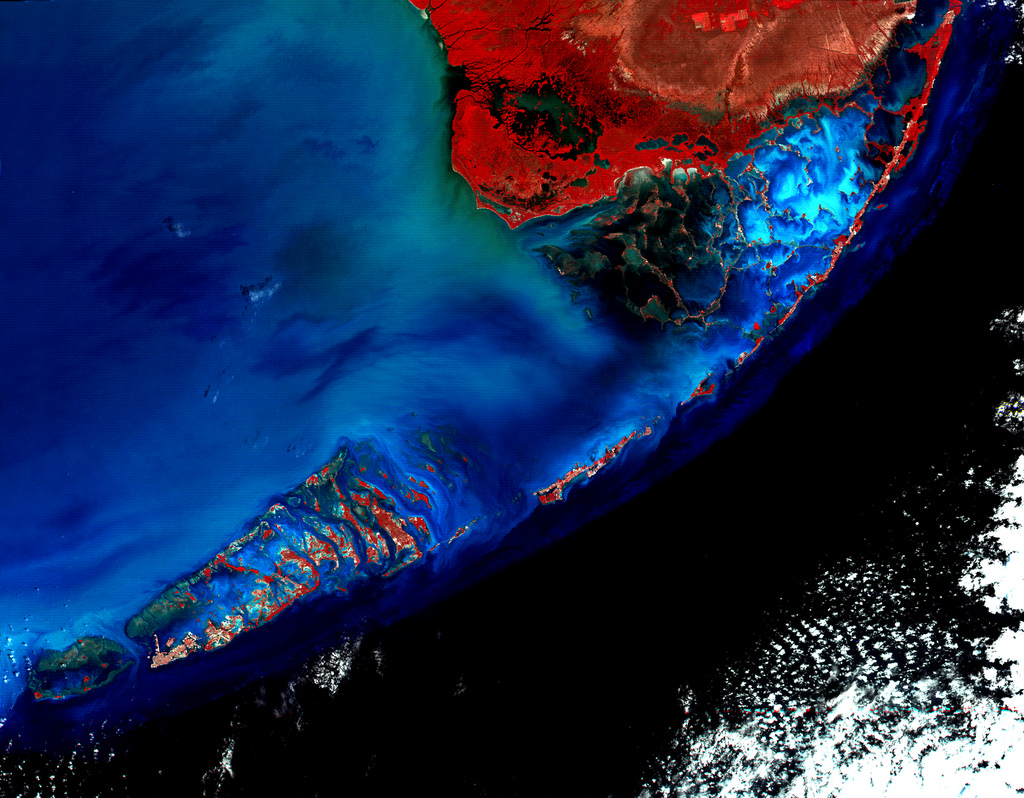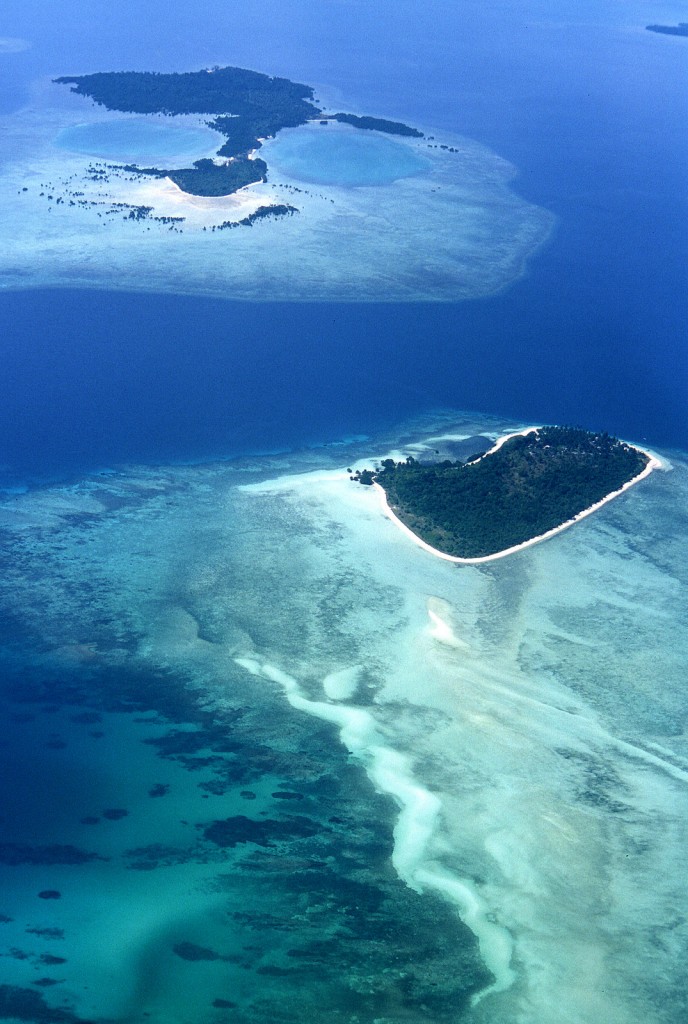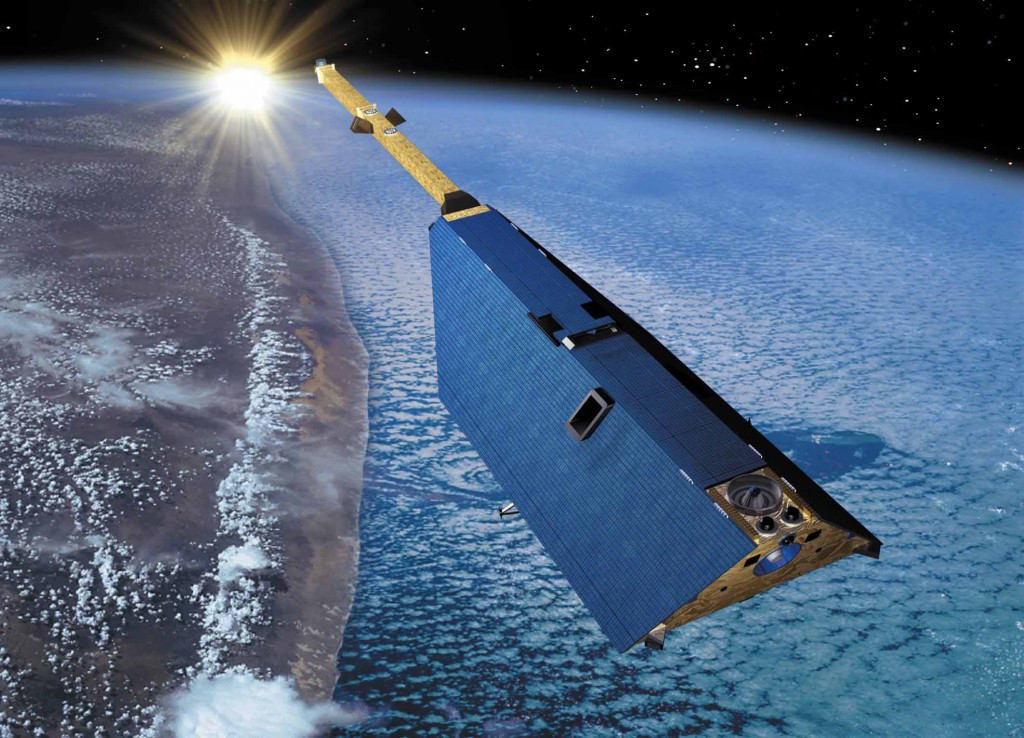The Coral Reef Satellite Mission – from Sea to Space
Vision Statement
To stop the destruction of the world’s coral reefs by 2020 and restore their beauty, health and abundance within this century.
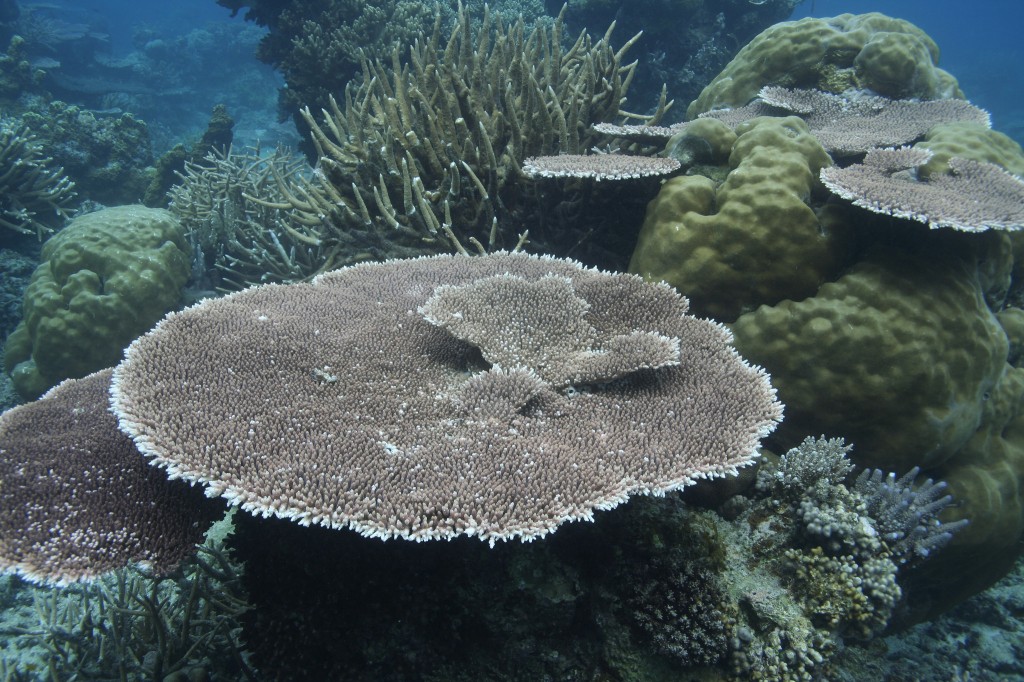
Healthy Coral Reef in Bali. © Orla Doherty, Biosphere Foundation
“Coral reefs are the rainforests of the sea, the seat of its biodiversity, and the strongest indicator of its health but reefs are dying at an alarming rate. 38% of Florida’s coral reefs died in just four years. Rising water temperatures caused by global warming, as well as industrial and organic pollution, are major factors in coral death. The Planetary Coral Reef Foundation has a sound plan to use satellite technology to get global baseline data on reef health. Only with the data in hand, and with the problem quantified and understood, can the alarm be made clear and credible enough for people to demand that their governments take action. We must act now to preserve a biological heritage which has been created over hundreds of millions of years.”
– James Cameron, Filmmaker, Diver, Deep-Sea Explorer
The Coral Reef Satellite Mission (CRSM) Team
To fulfill this mission, PCRF assembled a world-class team of advisors, scientists, engineers and institutions. To date, all members of this prestigious team have contributed their expertise and time to the CRSM on an entirely pro bono basis because they believe in the project and we are grateful for their dedication and generous support. Click here to know the team.
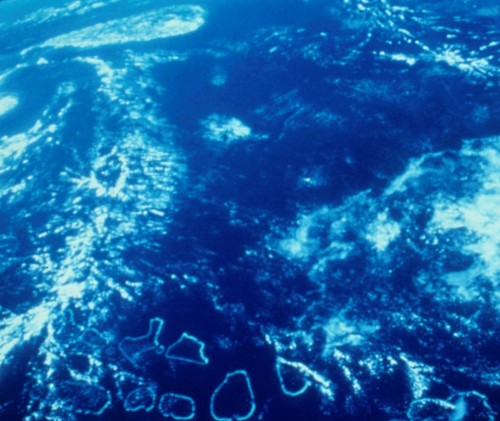
Executive Summary
Why Coral Reefs Are Important
Coral reefs are the most biodiverse marine ecosystem and the greatest expression of ocean life. Home to more than a quarter of all fish species, reefs and their habitats play a vital role in the global economy, providing resources and services worth an estimated $375 billion per year including: food for an estimated 10% of the world’s population, fish nursery habitats, shoreline protection from erosion, pharmaceuticals and tourism. Also known as the “rainforests of the sea,” coral reefs are the most sensitive ecosystem on Earth and the first to show signs of distress in response to environmental change. For this reason, coral reefs are considered an indicator for the health of the world’s oceans, and by extension the health of our global environment.
The Coral Reef Crisis
Coral reefs are now in crisis – dying at an alarming rate worldwide. An estimated 25% of coral reefs have already disappeared and an estimated two-thirds of all coral reefs are at risk today. In Southeast Asia, more than 88% of the reefs are at risk and the reefs in the Florida Keys have lost more than 92% of their living coral cover since 1975. Threatened by pollution, over-fishing, dynamite and cyanide fishing, sedimentation as well as bleaching caused by rising ocean temperatures and ocean acidification due to increased atmospheric CO2, coral reefs are now endangered on a planetary scale. If immediate action is not taken, coral reefs could disappear from Earth within this century. A global collapse of coral reefs and their related habitats would be catastrophic and poses grave environmental security issues. The stakes are high, as the future of life on our planet depends on the health of our oceans and the health of our oceans depends on the health of our coral reefs.

This set of photographs, taken from the same vantage point ten years apart, illustrates the rapid degradation of coral reefs that has occurred throughout the Florida Keys and Caribbean Sea. Carysfort Reef, the largest and most luxuriant reef in the Florida Keys, has lost over 92% of its living coral cover from pollution, disease, and physical damage since 1975 when monitoring began.
Baseline Satellite Imagery for Coral Reefs Urgently Needed
Despite their importance, relatively little is known about coral reefs. Remarkably, there is no comprehensive global baseline map of living coral reefs. It is therefore impossible to measure the rate at which the reefs are dying with accuracy. By contrast, scientists know exactly how much rainforest is being destroyed every day because there is a very detailed baseline provided by satellite imagery. A comparable baseline for coral reefs is urgently needed. Until this is achieved, we will not have the information we need to address the coral reef crisis on a global scale: where are the reefs, what condition are they in, what threats to they face, as well as how and how fast are they changing?
The Solution: Remote Sensing of Coral Reefs
Today, the best way to obtain an accurate, global baseline map of living coral reefs is through a multi-faceted approach combining in situ underwater photography, measurements and assessments – so-called ‘ground-truthing’ with ‘real-time’ satellite imagery. Yet satellite mapping and monitoring of coral reefs pose unique challenges. Unlike the rainforests, reefs are underwater and often not visible to the naked eye. In effect, the curtains of air and water above coral reefs must be removed to “see” them and detect change. This can only be accomplished through remote sensing – specifically by pioneering a special space-based coral reef sensor.
Pioneering a Coral Reef Satellite Mission
The Planetary Coral Reef Foundation (PCRF), a non-profit 501 (c) (3) organization, was founded in 1991 with this bold mission in mind. To fulfill this mission, PCRF assembled a world-class team of advisors, scientists, engineers and institutions. After more than a decade of meetings, conferences, published papers and very hard work, this team conclusively proved that it is indeed possible to map and monitor coral reefs from space and joined PCRF in this pioneering effort to launch a Coral Reef Satellite Mission (CRSM). 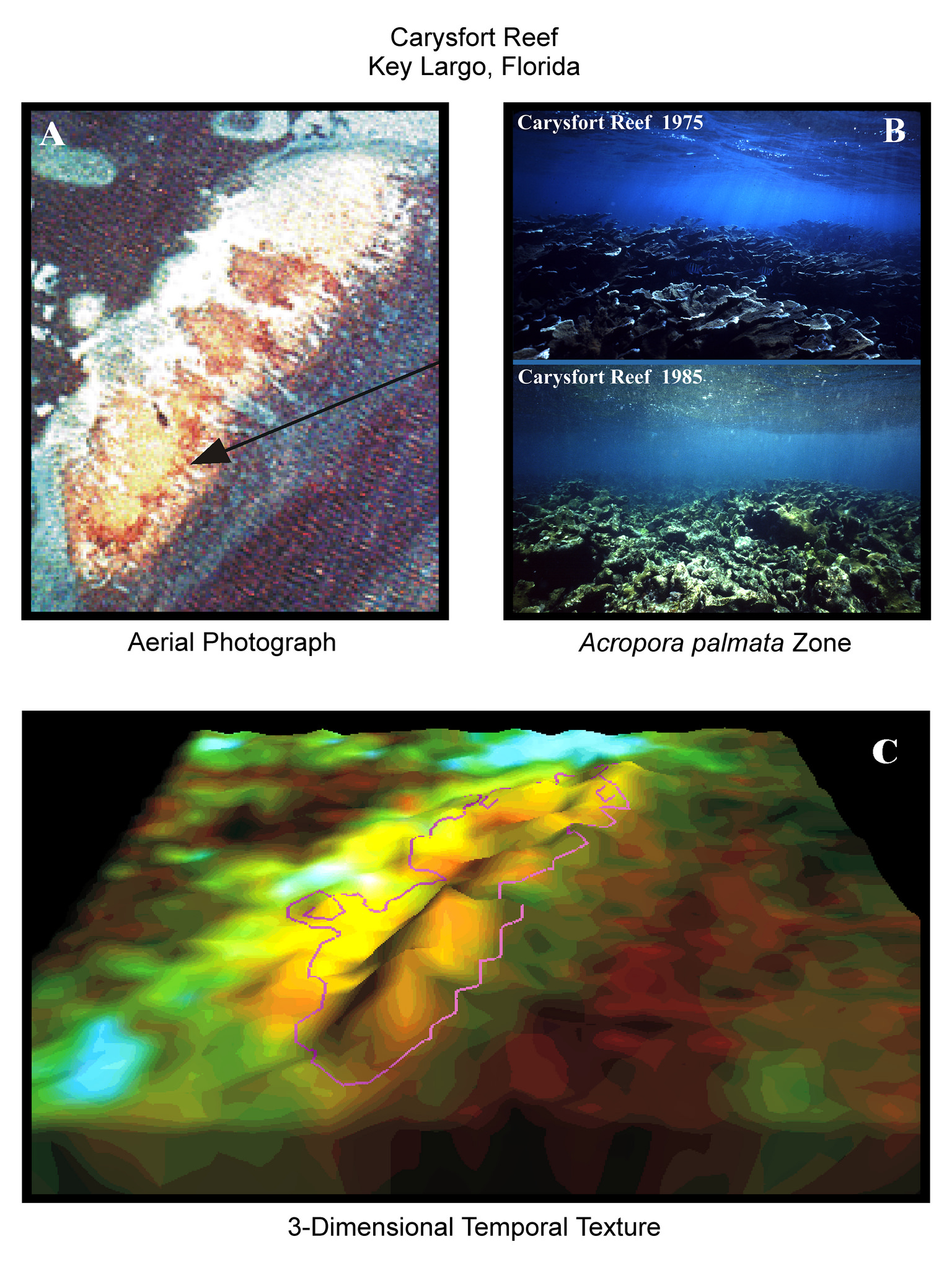 To date, all members of this prestigious team have contributed their expertise and time to the CRSM on an entirely pro bono basis because they believe in the project, and it is estimated that the total value of their donated services now exceeds $5 million. As scientists and engineers, they are very excited by the unique challenges posed by coral reefs, by the phenomenal data the CRSM will provide for research and by the promise of new discoveries. Perhaps even more important, all have been inspired to work countless hours and dedicate themselves to producing a Mission Description Document because the CRSM vision offers a purpose that goes far beyond the merits of pure science: the application of space technology for the benefit of life on earth, specifically, for the critical preservation and restoration of the disappearing coral reef ecosystem.
To date, all members of this prestigious team have contributed their expertise and time to the CRSM on an entirely pro bono basis because they believe in the project, and it is estimated that the total value of their donated services now exceeds $5 million. As scientists and engineers, they are very excited by the unique challenges posed by coral reefs, by the phenomenal data the CRSM will provide for research and by the promise of new discoveries. Perhaps even more important, all have been inspired to work countless hours and dedicate themselves to producing a Mission Description Document because the CRSM vision offers a purpose that goes far beyond the merits of pure science: the application of space technology for the benefit of life on earth, specifically, for the critical preservation and restoration of the disappearing coral reef ecosystem.
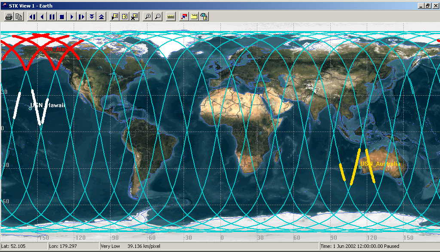
USN Antenna Coverage for the CRSM Satellite
CRSM Vision: A Global Campaign to Save Coral Reefs!
The CRSM vision proposes utilizing the data not only for traditional research but as a platform for a global action campaign for coral reef stewardship. The mission will provide the first comprehensive global baseline map of living coral reefs and the most scientific, accurate, real-time information about changes in coral reef conditions, thus providing the world the information urgently needed to preserve and protect coral reefs worldwide. For the very first time, this information will be disseminated for free worldwide via the internet on PCRF’s web site, www.pcrf.org. People will be able to sit at their computers anywhere in the world, log on to the Internet and “witness” the global destruction of reefs – the underwater world of reefs will no longer be “out of sight and hence out of mind.” Imagine the concern it would raise if like the reefs in the Florida Keys, Yosemite had lost over 92% of its forest since 1975! To maximize global participation and distribute information about coral reefs as widely as possible, this internet-based environmental satellite system will be coupled with a call to action to Save Coral Reefs! The vision for this site is to launch a new means of planetary stewardship whereby internet users everywhere – even in the remotest of locations – will be encouraged to make a difference in the future of coral reefs. A menu of opportunities will be offered for this purpose ranging from innovative education, outreach and research programs to collaborative conservation and public policy initiatives at local, national, regional and international levels.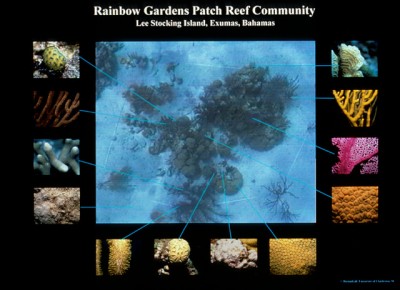 Also for the very first time, the CRSM will make it possible for policymakers, NGOs and anyone interested in coral reef conservation to access a standardized “trusted source” of unbiased, real-time data about the state of the world’s coral reefs. The data provided by the mission can thus be used to inform better legislation, public policy strategies, critical conservation decisions such as identifying the most effective locations for Marine Protected Areas and management practices to steward reefs worldwide. Without the CRSM data, the coral reef crisis cannot be tackled on a global scale, and the prospects of a world without reefs are devastating – for the global economy, for a hungry and ever growing world population, for the sustainability of the oceans and for the life of all future generations.
Also for the very first time, the CRSM will make it possible for policymakers, NGOs and anyone interested in coral reef conservation to access a standardized “trusted source” of unbiased, real-time data about the state of the world’s coral reefs. The data provided by the mission can thus be used to inform better legislation, public policy strategies, critical conservation decisions such as identifying the most effective locations for Marine Protected Areas and management practices to steward reefs worldwide. Without the CRSM data, the coral reef crisis cannot be tackled on a global scale, and the prospects of a world without reefs are devastating – for the global economy, for a hungry and ever growing world population, for the sustainability of the oceans and for the life of all future generations.
Budget
The Coral Reef Satellite Mission is currently estimated to be a $150 million effort. This includes design and fabrication of both the coral reef sensor suite and spacecraft bus, the satellite launch and five years of operations. Mission operations will involve retrieval, processing and calibration of data sets to be made available in near real-time. It will also involve data translation and distribution in different formats to scientists, governments, the international conservation community and general public. Once financing is in place, it will take approximately four years to design, integrate and launch the satellite. During the first five years of operation, the CRSM will produce the urgently needed global baseline map of living coral reefs, enable the world to witness changes in coral reef ecosystems on a planetary scale and launch a global stewardship campaign to Save Coral Reefs. Naming rights for the satellite will be awarded to an investor who fully funds the CRSM.
Coral Reef Fact Sheet
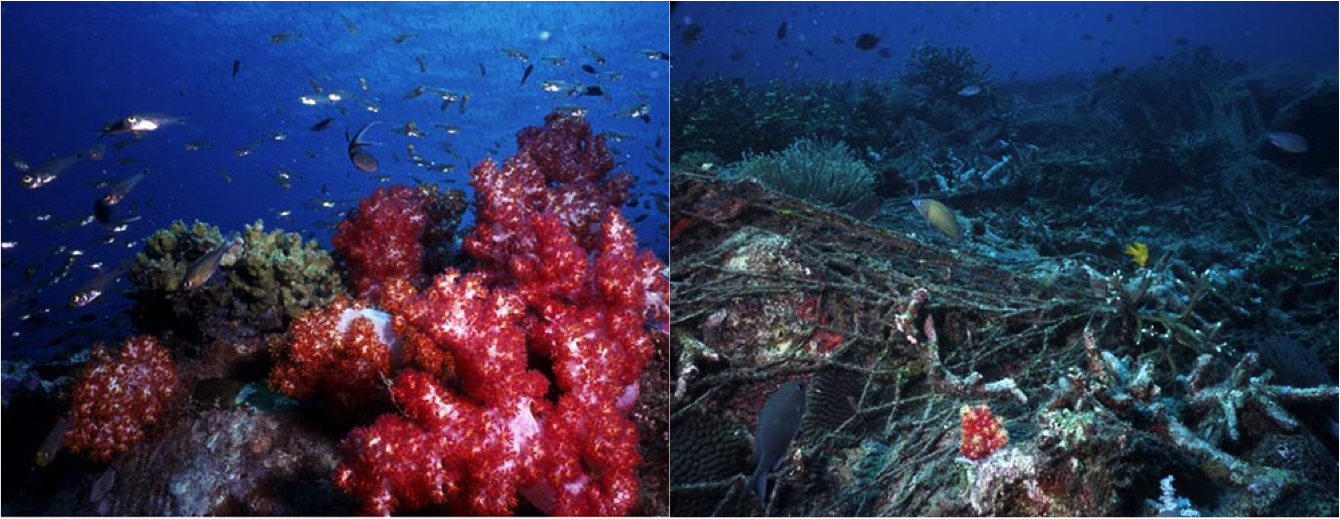
Healthy Coral Reef, Southeast Asia (left) vs. Damaged Coral Reef, Indonesia (right)
- Called the “rainforests of the sea,” coral reefs are the greatest expression of ocean life, and are the most biodiverse ecosystem on Earth, with 30 of 34 known animal phyla present.
- Coral reefs are the indicator for the health of the world’s oceans and by extension, our global environment.
- An estimated 25% of coral reefs have already disappeared and an estimated two-thirds of all coral reefs are at risk today.*
- Coral reefs are in crisis, dying at an alarming rate worldwide.
- An estimated 88% of the reefs in the Coral Triangle of Southeast Asia – the most species rich reefs on earth – are at risk.*
- Between 1996 and 2000, the Florida Keys suffered an estimated 38% loss of coral reefs, and the reefs in the Florida Keys have lost more than 92% of their living coral cover since 1975.
- Threats to the world’s coral reefs include:
- Land-based Pollution
- Disease
- Over-fishing
- Dynamite and cyanide fishing
- Sedimentation
- Bleaching caused by rising ocean temperatures
- Ocean acidification caused by burning fossil fuels
- Lining 60,000 miles of shoreline along 109 countries, coral reefs and their habitats play a vital role in the global economy, providing resources such as fish, and services such as tourism and coastal protection worth an estimated $375 billion a year.*
- Unlike the rainforest, there is no comprehensive global baseline map of living coral reefs. This is urgently needed. A satellite mission dedicated to remote sensing of coral reefs can provide this critical global baseline.
*Please see Reefs at Risk series, World Resources Institute.
The most important fact: There are solutions to this crisis. You can make a difference and help save coral reefs!

